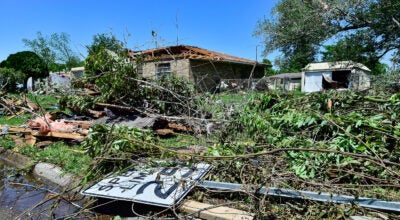Endangered whooping cranes to be released into SW Louisiana marsh today
Published 9:14 am Sunday, December 28, 2014
NEW ORLEANS — If it’s not too windy for a first flight, too foggy to see or so rainy that it would drench biologists’ baggy “crane costumes,” and there aren’t too many aggressive adults in the neighborhood, 14 young endangered whooping cranes will be released today into a Southwest Louisiana marsh.
For the second year in a row, adults released in earlier years have been dropping by while the patchy cinnamon-and-white youngsters were penned, said Sara Zimorski, one of the Louisiana Department of Wildlife and Fisheries biologists who have been caring for the cranes since they arrived Dec. 4 from Maryland and Wisconsin, where they were hatched and raised.
For their first weeks in Louisiana, juveniles are kept in a covered round pen 70 feet across, itself within 1½ acres fenced to keep out predators such as alligators or coyotes.
“Last year, I think at one point there were 10 adults outside. Different groups came, but only one male stayed. Others came for a few days, then went back up,” she said Wednesday.
This year has been similar, she said, with adults staying a day or two, then returning to the area they usually live in.
The reason for the returns isn’t clear, she said. “It makes you think, ‘They haven’t been around all summer and fall. Why now?’” she said. “It’s as if, ‘Hey, new birds — check it out!’”
The 5-foot-tall adults, white with a red cap and black “mustache” and wing tips, are North America’s tallest flying birds and one of the world’s most endangered birds. Only 22 were alive in 1941. They now number about 600, nearly 200 of them captive.
This is the fifth group of juveniles brought to White Lake, about 155 miles west of New Orleans, in hope of creating a third wild flock. The nation’s only natural flock migrates between Canada and Texas; ultralight planes have been used to teach a smaller flock to migrate between Wisconsin and Florida.
The 14 juveniles bring Louisiana’s experimental flock to 40 birds. A total of 64 have been brought to White Lake since early 2011. Most of the 24 deaths were from illness or natural predators, though five birds were shot.
Food will be set out in their pen until they’re used to finding fish, crawfish, tubers, snakes, turtles, crabs, clams, frogs, rodents, small birds and berries for themselves.
“Last year a pair of particularly aggressive adults chased the juveniles away from the pen” after they were released, Zimorski said. “We just removed the food” and the adults eventually left.
All of the birds wear tracking transmitters, so biologists knew the juveniles were still nearby when the adults left. “Once the adults were gone, we put the feeders back,” Zimorski said.
Last year’s release also taught biologists that gusty wind can be a problem. One bird wound up on the levee where blinds are set up to watch the release. A couple landed in a canal. They swam to the bank but biologists had to help them up and over thick brush, Zimorski said.
“Everybody was fine last year,” she said. “It was just a little more chaotic than we’d have liked.”
Although biologists wear hip-boots, heavy rain can soak the calf-length costumes worn to keep the big chicks from thinking people are their parents or even safe to be around, making them heavy and awkward. And, what’s worse, they cling to clothes below, showing a more human outline.
“It makes us more visible — we’re not just this shapeless blob,” Zimorski said.
Zimorski said the releases never get old.
The cranes have never flown outside of a covered pen, and don’t realize at first they have freedom to take off, she said.
“Sometimes they’re a little awkward at first, figuring how to land and take off. They quickly get graceful and fly like pros.
“It’s always fun to watch.”
—
Online:
http://www.wlf.louisiana.gov/wildlife/whooping-cranes
International Crane Foundation: http://www.savingcranes.org/
Whooping Crane Eastern Partnership: http://www.bringbackthecranes.org/
Texas cranes: http://www.fws.gov/refuge/Aransas/wwd/science/updates.html





